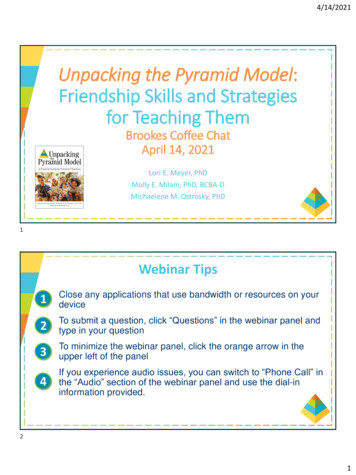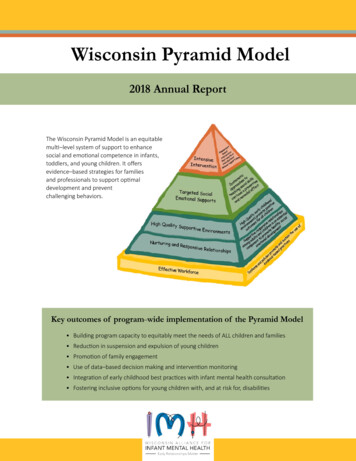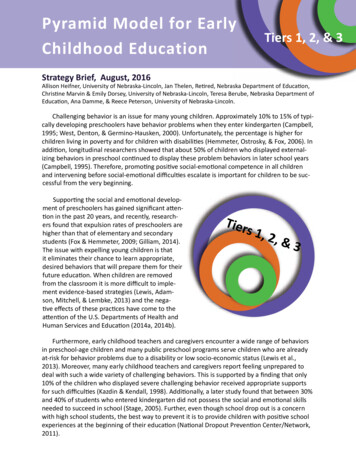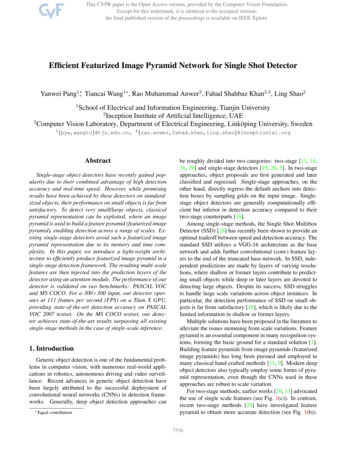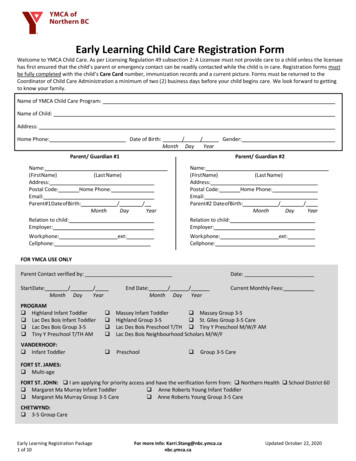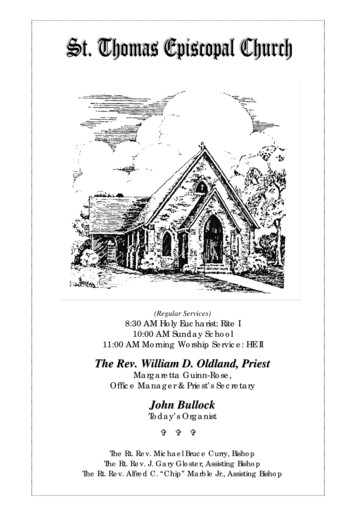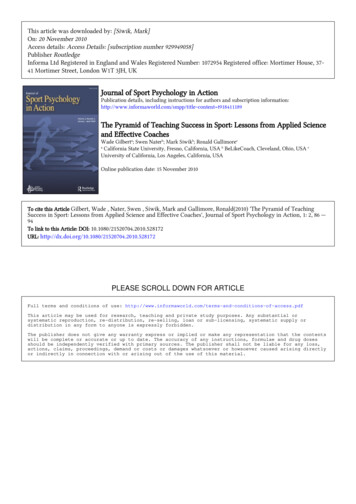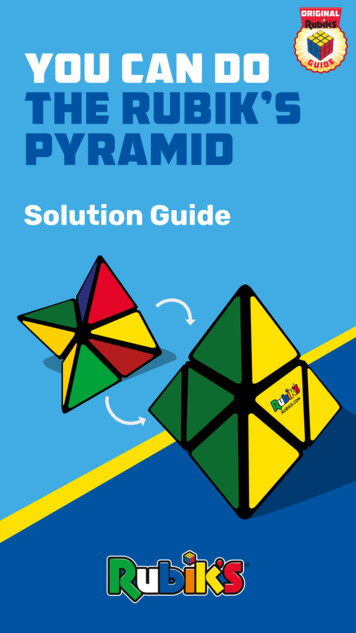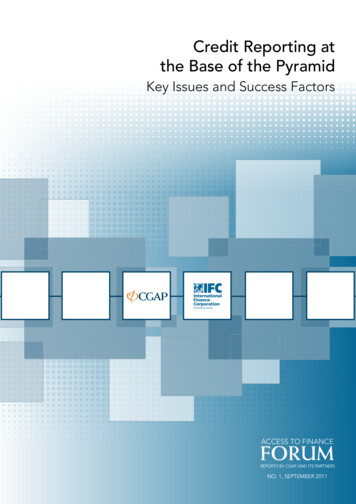
Transcription
NC Preschool Pyramid Model: Tier II SupportsModule1: Handout 1NC Preschool Pyramid Model (PPM)Early Childhood Plan for Addressing Challenging BehaviorsEarly ChildhoodPlan for Addressing Challenging BehaviorsAddressing challenging behaviors in preschool requires three tiers of prevention and intervention supports, asoutlined in the NC Preschool Pyramid Model in North Carolina: Tier I: Implementing universal practices/strategiesTier II: Collecting data and implementing targeted strategiesTier III: Planning the Functional Behavior Assessment and Behavior Support Plan.Implementing strategies and supports at each tier of the model with fidelity greatly decreases the occurrence ofbehavior that is out of control.Tier I: Implementing universal practices/strategies. The first tier involves establishing universalpractices to support and promote emotional and social development for all children. Practices include:promoting positive relationships, setting up supportive environments, and providing instruction on emotionalliteracy, regulating emotions, and problem solving.Tier II: Collecting data and implementing targeted strategies. The second tier involves targetedsupport for children with emotional and social developmental delays or other risk factors who need morepractice and assistance in order to understand emotions and learn and apply social skills. At the second tier,teaching staff and families work together to gather data to describe children’s challenging behavior in order toidentify specific skills and situations that require more attention and specific strategies to improve behavior.Tier III: Planning the Functional Behavior Assessment and Behavior Support Plan. The third tier ofsupports are implemented when children continue to exhibit challenging behaviors after the first two tiers ofpractice have been implemented to fidelity. At the third tier, a ‘behavior support team’ assembles to conduct a‘functional behavior assessment,’ including a review of the data collected at the second tier and otherinformation that describes the antecedent, contextual events, and consequences of persistent challengingbehavior. With this information, the team develops a ‘behavior support plan’ which includes specific strategiesfor replacing the challenging behavior, assuring that the challenging behavior is not inadvertently rewarded, andeliminating or decreasing triggers associated with the challenging behavior.Preschool programs must have in place a written plan and set of procedures so that teaching staff andadministrators will know what to do when challenging behaviors occur. Written plans should include thespecific procedures to be implemented, including documentation that procedures have been followed, at eachtier of the three-tiered framework. All teaching staff should review and understand the early childhood plan foraddressing behaviors so that they will be aware of the process, recommended strategies, and plan forcommunicating a need for support.The purpose of this document is to develop consistent practices and procedures when addressing challengingbehaviors in the preschool setting. To successfully implement a plan for addressing challenging behaviors,teaching staff in preschool programs must be trained in Effective Teacher Practices Supporting the NorthCarolina Foundations for Early Learning and Development (Modules 3-11) and the preschool program must havean established early childhood behavior support team. The behavior support team is responsible for taking thelead in assuring that the early childhood plan for addressing challenging behaviors is implemented. An earlychildhood behavior support team should include a member or members who can provide initial consultation toRevised December 2018
2a teacher once a persistent challenging behavior is identified and give guidance and support for conducting afunctional behavior assessment if the need arises. All teaching staff should review and understand the earlychildhood plan for addressing challenging behaviors so that they will be aware of the process, recommendedstrategies, and plan for communicating a need for support. It is important to emphasize that throughout theprocess of addressing challenging behaviors, teaching staff and/or the behavior support team must be in closecommunication with the families involved so families are well informed and have the opportunity to offer theirown information, strategies, and data to support the process.Where can I access training information on Effective Teacher Practices Supporting the North CarolinaFoundations for Early Learning and Development?Trainers across the state of NC have attended train-the-trainer sessions where they received the materials andsupport needed to conduct trainings locally. The materials for trainers are posted module-intro. Self-paced e-modules are also available forlearners here: s.What is challenging behavior?Any repeated pattern of behavior, or perception of behavior, that interferes with or is at risk of interfering withoptimal learning or engagement in pro-social interactions with peers and adults that interferes with children’slearning, development, and success at play; is harmful to the child, other children, or adults; that put a child athigh risk for later social problems or school failure. Challenging behavior is thus defined on the basis of itseffects. While some children’s challenging behaviors are developmentally or culturally normative and effectivelyaddressed by adult vigilance and the use of appropriate guidance procedures, other children need moretargeted evidence-based practices (Tier II) to prevent and/or address challenging behaviors that are persistentor unresponsive to universal evidence-based /Pyramid/overview/glossary.html; Dunlap, Strain, Fox, et al., 2006).Examples of persistent challenging behaviors for preschool children may include: (1) physical aggression such ashitting, kicking, punching, spitting, throwing objects forcefully, pinching, pushing, and biting; (2) climbing onthings in the classroom that are not permitted; (3) destroying property, destroying what another child is workingon regardless of the other child’s response; (4) taking toys away from other children forcefully; (5) running thatposes a safety risk for the child or others or elopement from the classroom; (6) tantrum behaviors that mightinclude behaviors such as kicking, screaming, pushing an object or person, stomping feet, or head banging; (7)verbal aggression including yelling, threats, screaming at another person, calling children bad names, and sayingbad words; (8) ordering an adult to do something (e.g., “leave me alone”); (9) persistent or prolonged crying thatis loud or disruptive or ongoing crying that interferes with the child’s engagement in activities; (10)inappropriate use of materials (e.g., jumping off chairs, slamming materials, throwing objects); (11) statementsthat are noncompliant (e.g., “I’m not going to do it”) or clear and explicit verbal or physical refusal to followdirections; or (12) inappropriate touching, stripping, and other behaviors that are hurtful, disruptive, ordangerous to self or others (Hemmeter, Fox, & Snyder, 2014, p. 24).For infants and toddlers, challenging behavior must be considered within the context of the relationship of thechild to caregivers. Behavior that is challenging, for example, may manifest as attachment difficulties, sleepingand eating difficulties, excessive crying, and difficulty in soothing. Challenging behaviors may be defined asbehaviors that interfere with the development and maintenance of reciprocal, positive, and nurturingrelationships with the parent or caregiver verview/glossary.html).Revised December 2018
3What is an early childhood behavior support team?A behavior support team consists of people who are responsible for taking the lead in assuring that the earlychildhood plan for addressing challenging behaviors is implemented. Suggested members include preschoolcoordinators, Exceptional Children Program directors, childcare program directors, principals, professionals withbehavior expertise, such as behavior specialists, psychologists, social workers, etc., resource professionals,teachers, and any other key stakeholders.1. List the members of the early childhood behavior support team along with contact information:2. Identify which of the behavior support team members will be involved directly with conducting FunctionalBehavior Assessments (FBAs) if the need arises at the third tier of support:3. Indicate who the teaching staff should contact directly once he/she identifies a need for support withaddressing challenging behaviors in the classroom:4. Describe the process for offering initial support and communicating with the early childhood behaviorsupport team once teaching staff identifies a need for support with addressing challenging behaviors in theclassroom. Be sure to include any considerations that must be addressed if the child already has an IEP orexisting behavior support plan:Tier I: Implementing Universal Practices/StrategiesThe best way to prevent serious and persistent challenging behaviors is to implement a tiered framework ofprevention and intervention practices and strategies. In the NC Preschool Pyramid Model, this framework hasthree tiers. Implementing strategies at each tier of the model with fidelity greatly decreases the occurrence ofout of control behavior. The first tier involves establishing universal practices to support and promoteemotional and social development for all children, including promoting positive relationships, setting upsupportive environments, and providing instruction on emotional literacy, regulating emotions, and problemsolving. Once a teaching staff member identifies a need for support with responding to challenging behaviors,he/she will complete a self-assessment using the NC Preliminary Pyramid Assessment (PPA) checklist (SeeAttachment I: NC Preliminary Pyramid Assessment). Teaching staff will also consult with a supervisor, coach, orother identified member of the early childhood behavior support team. This support person will work with theteaching staff to develop a precision statement about the challenging behavior and schedule time to observethe classroom using the NC PPA checklist. After the observation, the support person will develop a plan forsupport that may include training, coaching support, consultation, or other strategies and will follow up toRevised December 2018
4determine the effectiveness of the support. The support person will also view and discuss the ClassroomBehavior Record and the Early Childhood Behavioral Engagement Report with the teaching staff. If the childhas an IEP, the IEP team must be involved once challenging behaviors persist so they can follow establishedguidelines and procedural safeguards for reviewing and updating the IEP accordingly.Where can I find more information on the tiered model and strategies to use for each tier?More information on the preschool pyramid model for emotional and social development and suggestedstrategies and tools to be implemented at all tiers of the pyramid model can be found at the following du/http://csefel.vanderbilt.edu/What is a precision statement of challenging behavior?In order to begin the process of addressing challenging behavior, the behavior needs to be clearly defined. Theguidance for developing a precision statement for problem behavior can be used to clearly define andcommunicate the behavior. See Attachment II: Developing Precision Statement for Problem Behavior.What is the Classroom Behavior Record?The classroom behavior record is used to record data for children who have been identified as needing Tier IIinterventions. It is a data collection tool that helps to measure the occurrence of challenging behaviors and alsotrack progress once targeted strategies are implemented to address the behaviors. See Attachment III:Classroom Behavior Record.Why is the Early Childhood Behavioral Engagement Report reviewed at the beginning of the process?Although it is rare for a child in a preschool program to be suspended, it is important to review the EarlyChildhood Behavioral Engagement Report form and note strategies implemented to address challengingbehavior throughout the process. In the event that a child is suspended, the documentation of strategies used toprevent suspension will be recorded. See Attachment IV: Early Childhood Behavioral Engagement Report.1. Describe this process you use locally to determine the extent to which universal (Tier I) practices arebeing implemented. Identify who will work with teaching staff to discuss challenging behavior, conductan observation, and make a plan for next steps:2. Describe the support to be provided after the observation and the process for determining if challengingbehaviors persist after supports and strategies have been implemented. Include any considerations thatmust be addressed if the child already has an IEP or existing behavior support plan:3. Describe how updates and progress will be shared with the early childhood behavior support team:Revised December 2018
5Tier II: Collecting Data and Implementing Targeted StrategiesThe second tier involves providing targeted support to children who need more practice and assistance withlearning and applying emotional and social skills. The children who tend to need second tier supports usuallyhave emotional and social developmental delays or are have other risk factors that lead to displaying challengingbehavior. At the second tier, teaching staff and families work together to gather data on challenging behavior inorder to identify specific skills and situations that require more attention and specific strategies to implement inorder to improve behavior. Teaching staff will implement and assess effectiveness of strategies for improvingchallenging behavior for a period of at least six weeks. As part of data collection, teaching staff should continueto use the Classroom Behavior Record and Early Childhood Behavioral Engagement Report to documentpersisting behavior and strategies used to address behavior. If the child has an IEP, the IEP team must beinvolved so they can follow established guidelines and procedural safeguards for reviewing and updating the IEPaccordingly.What data needs to be collected at the second tier?Observation data will need to be gathered to identify possible triggers for behavior and also identify skillsneeding more direct instruction, targeted support, and progress monitoring. The Classroom Behavior record andEarly Childhood Behavioral Engagement Report should also continue to be used to document behavior observedand strategies implemented and to note progress or changes over time. If a child has an IEP, the IEP team shouldbe consulted to determine any other necessary data collection.What are some ways in which families can be involved with data collection and implementing strategies toimprove behavior?Families can help with data collection by noting occurrences of challenging behavior and strategies implementedin the home and community settings and by tracking any progress or changes. Families can be valuableresources when developing strategies to address behavior by providing examples of what works in the homeand community, including motivators and the child’s preferences and strengths.1. Describe the ways teaching staff will collect and record data as challenging behaviors persist even whenthe universal strategies have been implemented at tier one. Identify specific data collection tools/logsthat you will use to record characteristics of challenging classroom behavior and track effectiveness ofstrategies. Describe how families will be involved. Include any considerations that must be addressed ifthe child already has an IEP or existing behavior support plan:2. Describe how teaching staff will receive support as he/she collects data, identifies skills and situationsrequiring more attention and targeted instruction, and implements strategies:3. Describe how updates and progress will be shared with the early childhood behavior team and what rolebehavior support members will play at the second tier:Revised December 2018
6Tier III: Planning the Functional Behavior Assessment and Behavior Support PlanThe third tier of supports are for children who display persistent challenging behaviors even after the first twotiers have been implemented to fidelity. At the third tier, the behavior support team assembles to plan afunctional assessment of the behavior, which includes a review of the data collected at the second tier and otherrelevant information related to the antecedent, contextual events, and consequences of persistent challengingbehavior. This information is used to develop a behavior support plan, which includes specific strategies forreplacing the challenging behavior, assures challenging behavior is not inadvertently rewarded, and eliminatesor decreases triggers associated with the challenging behavior. Community mental health resources available tothe child and family should be explored and shared with the family. An individual or individuals with behavioralexpertise should be identified for coaching staff and families throughout the process of developingindividualized intensive interventions for children in need of behavior support plans. If the child has an IEP, theIEP team must be involved once challenging behaviors persist so they can follow established guidelines andprocedural safeguards for reviewing and updating the IEP accordingly. As part of data collection, teaching staffshould continue to use the Classroom Behavior Record and Early Childhood Behavioral Engagement Report todocument persisting behavior and strategies used to address behavior.How does data collected during the second tier inform planning at the third tier?All of the data collected at Tier II can be used to inform the Functional Behavior Assessment that occurs at TierIII. By collecting data throughout the process, the FBA can often be a more streamlined process since the datacollected includes information on the challenging behavior and strategies that have been implemented up tothat point.1. Describe the process of assembling the behavior support team for the purpose of planning a functionalbehavior assessment and behavior intervention plan. Describe how families will be involved. Include anyconsiderations that must be addressed if the child already has an IEP or existing behavior support plan:2. List existing mental health resources in the community and describe how those are shared with thefamily:3. List individual(s) on the behavior support team with behavioral expertise who will coach staff andfamilies through the process:Revised December 2018
7ReferencesBranscomb, T., Carter, K., Cocores, G., McComas, N., Nolan, C., & Thompson-Arbogast, P. (2016, October 7-8). Safety First. Lecturepresented at University of Oregon, Eugene.Dunlap, G., Strain, P., Fox, L., et al (2006). Prevention and intervention with young children’s challenging behavior: perspectives regardingcurrent knowledge. Behavioral Disorders, 32, (1), 29-35 (2006).Hemmeter, M.L., Fox, L., & Snyder, P. (2014). Teaching pyramid observation tool (TPOT) for preschool classrooms manual researchedition. Baltimore, MD: Paul H. Brooks Publishing Co.Revised December 2018
Attachment INC Preliminary Pyramid AssessmentThis checklist can be used when working with a teacher who has a child with a challenging behavior in his/herclass. This should be completed in conjunction with the following: 1) identifying when a challenging behavioris happening, 2) determining what exactly the behavior is, 3) identifying what happens before, during andafter the behavior occurs, and 4) developing a precision problem behavior statement. Indicate Yes for eachpractice/strategy that is in place (or observed) and indicate No for each practice/strategy not yet in place (ornot observed). Add additional comments or examples in the right hand column.Universal et the childCommunicate at eye levelInteract during routine activitiesRespond positively duringroutines and activitiesShow warmth and speak calmly tochildProvide positive attentionthroughout the dayProvide a comfortable, welcomeand safe space for the childJoin in children’s play to supportinteraction and expand ideasUse alternative strategies whencommunicatingReview visual schedule with childStructure routines from beginningto endExplicitly teach sequence oftransitionPrepare the child for transitionEnsure child is actively engaged intransitionProvide multiple opportunities tomake meaningful choicesStructure large group activities sochild is actively engagedDevelop and post classroomexpectationsRevised December 2018
Universal Practice/StrategyYesNoComments/ExamplesArrange traffic patterns inclassroom so there are no wideopen spacesClearly define boundaries inlearning centersArrange learning centers to allowroom for multiple childrenProvide a variety of materials in alllearning centersAssist child to select activity andengage in activityConsiders child’s interests whendeciding what to put in learningcentersMakes changes and additions tolearning centers on a regular basisStructure transitions so child doesnot have to spend excessive timewaiting with nothing to doPlan and conduct large groupactivities with specific goals in mindfor the childProvide opportunities for child tobe actively involved in large groupactivitiesMonitor child’s behavior andmodify plans when child losesinterest in large group activitiesPlan and conduct small groupactivities with specific goals in mindfor the childUse peers as models during smallgroup activitiesMake adaptations andmodifications to ensure that thechild can be involved in ameaningful wayUse a variety of ways to teach theexpectations of specific activities sothat the child can understand themUse and model rules/directions,oral and written, that are positivelyphrased, telling children what “todo” rather than what “not to do”Revised December 2018
Universal Practice/StrategyYesNoComments/ExamplesRecognize and respond to child'sideas and effortsShow empathy and acceptance ofchild’s feelingsProvide child with opportunities tomake choicesAllow child time to respond and/orcomplete task independentlybefore offering assistanceCreate opportunities for decisionmaking, problem solving, andworking togetherTeach child strategies for selfregulating behaviorsUtilize peers as models of desirablesocial behaviorEncourage peer partners/buddies(i.e., hold hands during transitions,play partner, clean-up buddy, etc.)Model phrases children can use toInitiate and encourage interactionsFacilitate interactions bysupporting and suggesting playideasEnsure that interactions are mostlychild-directed not teacher-directedduring free playTeach appropriate social skillsthrough lessons and role-playingopportunitiesIncorporate cooperative games,lessons, stories, and activities thatpromote altruistic behaviorStructure activities to encourageand teach sharingStructure activities to encourageand teach turn takingStructure activities to encourageand teach requesting anddistributing itemsStructure activities to encourageand teach working cooperativelyUse photographs, pictures, andposters that portray people invarious emotional statesRevised December 2018
Universal Practice/StrategyYesNoComments/ ExamplesUse validation, acknowledgment,mirroring back, labeling feelings,voice tones, or gestures to showan understanding of children’sfeelingsAssist child in recognizing andunderstanding how a classmatemight be feeling by pointing outfacial expressions, voice tone,body language, or wordsUse real-life situations to practiceproblem solving, beginning withdefining the problem andemotions involvedLabel own emotional states andprovides an action statement(e.g., I am feeling frustrated, so Ibetter take some deep breathsand calm down)Use opportunities to comment onoccasions when children statethey are feeling upset or angry butare remaining calmSystematically teach theproblem solving steps“Problematize" situationsthroughout the day to allow childopportunities to generatesolutionsSupport child through theproblem solving process duringheatedmomentsHelp child recognize cues ofemotional escalationHelp child identify appropriatechoicesHelp child try solutions until thesituation is appropriately resolvedDisplay photographs of childworking out situationsRevised December 2018
Attachment IIDescription of a Persistent Challenging Behavior1. Describe the problem behavior and how often it ishappening. What does the behavior look like? Howoften does the behavior occur throughout the dayand week? How long does the problem behaviortend to last?2. Where is the problem behavior most likely tohappen?3. Who is engaged in the behavior? Are there certainpeople who tend to almost always be involvedbefore or during the behavior?4. When does the problem behavior most likely occur?Does it occur at a particular time of day or during acertain activity?5. What is happening just before the problem behavioroccurs? What triggers the behavior?6. What happens as a result of the behavior? What dothe adults do? What do the other children do? Whatare the consequences?7. Why is the problem behavior continuing? Is theresomething the child is able to avoid or obtain as aresult of the behavior? What other lifestyle or settingchanges tend to influence behavior? For example,does problem behavior occur more often when thechild doesn’t sleep well, uses a different form oftransportation, takes medication, doesn’t eatbreakfast, doesn’t get outdoor time when it’s raining,has an unexpected change in a routine, arrives late orearly, etc.?Revised December 2018
Think about the sequence of the behavior:What Happens JustBefore?What Does theBehavior Look Like? What is the childdoing? What event, action,person, and/or requesttriggered the behavior? What lifestyle orsetting changes tend toinfluence occurence ofbehavior? What is the child doing? How long does it last? How frequent? Who else isinvolved/present? Where and when doesit happen?What HappensAfter? What do the adultsand/or other childrendo? Why does the child dothis?--what is the childable to obtain or avoidas a result of thebehavior?Write a precision problem behavior statement using the responses to questions 1-7 (see samples below):Sample Precision Problem Behavior Statements:A.What Happens JustBefore? Playing alone withtoys during centertime Told to put up toysand move to largegroup circleWhat Does theBehavior Look Like? Resisting, flailing,screaming, hitting Teacher/TA attemptto assist with puttingtoys away Occurs duringmorning center timeevery day 30 sec to a minute indurationWhat Happens After? Teacher/TA calmsAlyssa and holdsher hands, rubs herback, leads Alyssato large group circlewhile shereluctantly follows Teacher/TA putstoys awayRevised December 2018
Precision Problem Behavior Statement A:Every day, during morning center time, when it is time to put materials away and transition to large groupinstruction, Alyssa cries, holds her toys tightly and refuses to put them away repeatedly screaming, “No!”. Whenthe teacher or teacher assistant assists Alyssa by leading her to the appropriate bin or shelf, Alyssa flails about,screams and hits the teacher or teacher assistant. The teacher/teacher assistant holds Alyssa’s hands still andtalks calmly to her while rubbing her back for about 30-60 seconds and she stops flailing, hitting and screaming.The teacher/teacher assistant ends up removing the toys from her hands and putting them away and then holdsAlyssa’s hand and she reluctantly allows teacher/teacher assistant to lead her to the group activity.B.What Happens JustBefore? Rides bus to schoolinstead of ridingwith mother Greeted by teacherand other students Instructed to chooseor join activityWhat Does theBehavior Look Like? Sobs and criesuncontrollably, closes eyestightly, trembles, and hugshimself; sometimes throwsself on floor and rolls backand forth crying Teacher/TA attempt tocalm; offer choices forcenters using picture cardsbut he doesn't respond Occurs at the start of anyactivity in the morning(individual or group) Can last 2-7 minutesWhat HappensAfter? Teaching staff andstudents walk awayand move on withactivities while Kylecontinues to cry Kyle avoidsparticipating andsocializing Eventually moves toa center andparticipates afterseveral minutes ofcrying and sobbingPrecision Problem Behavior Statement B:Whenever Kyle rides the bus instead of riding with his mother in the morning, he sobs and cries, closes his eyestightly, and trembles and hugs himself as he walks in the classroom. Anytime he is approached or told to choosean activity or join circle time before lunch, he continues this behavior sometimes throwing himself on the floorand rolling back and forth while he cries. He doesn’t respond to the teacher or teacher assistant when theyattempt to calm him by hugging him and offering choices for activities using picture cards. His loud crying andsobbing can last from 2-7 minutes. The teaching staff and students eventually walk away and leave himwherever he is as he continues to cry and avoid social interaction and participation. Kyle eventually moves to acenter and plays with toys after several minutes of crying and sobbing.Revised December 2018
Attachment IIIClassroom Behavior RecordClassroom teacher:Date:Directions: Write the child’s name in the left column who is demonstrating a persistent challenging behavior. Arrangethe chart according to your classroom sc
learning, development, and success at play; is harmful to the child, other children, or adults; that put a child at high risk for later social problems or school failure. Challenging behavior is thus defined on the basis of its . In the NC Preschool Pyramid Model, this framework has three tiers. Implementing strategies at each tier of the .
